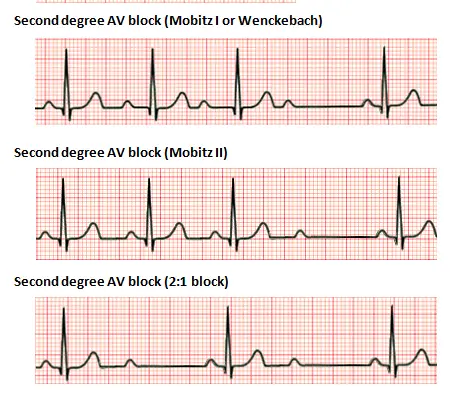Hello, my friends! In this lesson, we explore the four types of heart block. Heart block, also known as atrioventricular (AV) block, is a condition where there is a disruption in the electrical signals between the atria and ventricles of the heart. This can lead to a slower or irregular heartbeat, which can cause various symptoms and complications. There are four types of heart block: first-degree, second-degree type 1 (Wenckebach), second-degree type 2 (Mobitz II), and third-degree (complete) heart block. In this essay, we will compare and contrast the four types of heart block, including their ECG patterns, symptoms, diagnosis, treatment, and prognosis.

First Degree Heart Block: ECG Findings, Symptoms, Diagnosis, Treatment, and Prognosis
First-degree heart block is a type of heart block that occurs when there is a delay in the electrical signals that control the heartbeat. This delay can cause a prolonged PR interval on the electrocardiogram (ECG), which measures the electrical activity of the heart. In this essay, we will discuss the findings on ECG, symptoms, diagnosis, treatment, and prognosis of first-degree heart block.
On an ECG, first-degree heart block is characterized by a prolonged PR interval, which is the time between the start of the P wave (representing the electrical signal that causes the atria to contract) and the start of the QRS complex (representing the electrical signal that causes the ventricles to contract). Normally, the PR interval is between 120-200 milliseconds. In first-degree heart block, the PR interval is greater than 200 milliseconds.

First-degree heart block is usually asymptomatic, meaning it does not cause any noticeable symptoms. In some cases, patients may experience palpitations or a slow heart rate, but this is rare. Because it is often asymptomatic, first-degree heart block is typically found incidentally on routine ECGs.
The diagnosis of first-degree heart block is made through an ECG, which will show a prolonged PR interval. If first-degree heart block is detected, further testing may be necessary to determine the underlying cause, such as medication side effects, electrolyte imbalances, or other heart conditions.
Treatment for first-degree heart block is usually not necessary, as it is generally a benign condition. However, if the patient has underlying heart disease or other conditions that increase the risk of heart block progression, treatment may be necessary. This can include medication or lifestyle changes to address underlying conditions, such as hypertension or diabetes.
The prognosis for first-degree heart block is generally good. It is a benign condition that does not typically progress to more severe forms of heart block. However, patients with underlying heart disease or other conditions may be at increased risk for heart block progression and should be monitored regularly by a healthcare provider.
In summary, first-degree heart block is a mild form of heart block that is characterized by a prolonged PR interval on the ECG. It is typically asymptomatic and does not require treatment, but patients with underlying heart disease or other conditions may be at increased risk for heart block progression and should be monitored regularly.
Second-Degree Heart Block: Type 1 (Wenckebach) and Type 2 (Mobitz II)
Second-degree heart block is a type of heart block that occurs when some of the electrical signals controlling the heartbeat fail to reach the ventricles. There are two types of second-degree heart block: Mobitz type I (Wenckebach) and Mobitz type II. In this essay, we will discuss the findings on ECG, symptoms, diagnosis, treatment, and prognosis of these two types of second-degree heart block.
Second Degree Type 1 (Wenckenbach) Heart Block: ECG Findings, Symptoms, Diagnosis, Treatment, and Prognosis
Mobitz type I, also known as Wenckebach, is characterized by a progressive lengthening of the PR interval on the ECG, followed by a dropped beat. This cycle repeats itself, with the PR interval progressively lengthening until a beat is dropped. This cycle then starts again. On an ECG, this looks like a repeating pattern of several P waves followed by a QRS complex that is missing.

Symptoms of Mobitz type I second-degree heart block are usually mild and may include fatigue, dizziness, and fainting. However, in some cases, it may progress to more severe forms of heart block.
The diagnosis of Mobitz type I second-degree heart block is made through an ECG, which will show the characteristic pattern of progressively lengthening PR intervals followed by a dropped beat.
Treatment for Mobitz type I second-degree heart block may include monitoring the patient and treating underlying conditions that may be contributing to the condition. In some cases, a pacemaker may be necessary.
The prognosis for Mobitz type I second-degree heart block is generally good, but patients with underlying heart disease or other conditions may be at increased risk for heart block progression and should be monitored regularly.

Second Degree Type 2 (Mobitz II) Heart Block: ECG Findings, Symptoms, Diagnosis, Treatment, and Prognosis
Mobitz type II second-degree heart block is characterized by intermittent dropped beats on the ECG, without any preceding lengthening of the PR interval. On an ECG, this looks like a repeating pattern of P waves followed by a QRS complex that is missing, with no lengthening of the PR interval before the dropped beat.

Symptoms of Mobitz type II second-degree heart block may include dizziness, fainting, or chest pain. It is a more serious form of heart block and may progress to complete heart block if left untreated.
The diagnosis of Mobitz type II second-degree heart block is made through an ECG, which will show intermittent dropped beats without any preceding lengthening of the PR interval.
Treatment for Mobitz type II second-degree heart block may include close monitoring, treating underlying conditions, or the placement of a pacemaker to regulate the heartbeat.
The prognosis for Mobitz type II second-degree heart block is generally poorer than that of Mobitz type I, as it is more likely to progress to complete heart block. Patients with this condition should be closely monitored by a healthcare provider.
In summary, there are two types of second-degree heart block: Mobitz type I (Wenckebach) and Mobitz type II. Mobitz type I is characterized by a progressively lengthening PR interval on the ECG, followed by a dropped beat. Symptoms are usually mild, and treatment may include monitoring or a pacemaker. The prognosis is generally good. Mobitz type II is characterized by intermittent dropped beats without any preceding lengthening of the PR interval. Symptoms may be more severe, and treatment may include monitoring or a pacemaker. The prognosis is generally poorer than that of Mobitz type I.
Third-Degree Heart Block: ECG Findings, Symptoms, Diagnosis, Treatment, and Prognosis
Third-degree heart block, also known as complete heart block, is a serious condition in which the electrical signals that regulate the heartbeat are completely blocked, leading to a lack of coordination between the atria and ventricles. In this essay, we will discuss the findings on ECG, symptoms, diagnosis, treatment, and prognosis of third-degree heart block.
On an ECG, third-degree heart block is characterized by a complete dissociation between the P waves (which represent atrial contraction) and the QRS complexes (which represent ventricular contraction). This means that the atria and ventricles are beating independently of each other.

Symptoms of third-degree heart block can vary depending on the individual, but may include fatigue, dizziness, fainting, shortness of breath, chest pain, and palpitations. If left untreated, third-degree heart block can lead to heart failure or even sudden cardiac arrest.
The diagnosis of third-degree heart block is made through an ECG, which will show a complete dissociation between the P waves and QRS complexes.
Treatment for third-degree heart block may include the placement of a pacemaker, which can help regulate the heartbeat and prevent complications. In some cases, medications may also be prescribed to help control symptoms.
The prognosis for third-degree heart block can vary depending on the individual, but overall, it is a serious condition that requires prompt treatment. With appropriate treatment, however, many people with third-degree heart block are able to lead normal, healthy lives.
In summary, third-degree heart block is a serious condition in which the electrical signals that regulate the heartbeat are completely blocked, leading to a lack of coordination between the atria and ventricles. Symptoms can be varied and may include fatigue, dizziness, and chest pain. The diagnosis is made through an ECG, and treatment may include the placement of a pacemaker or medications. The prognosis can vary depending on the individual, but with appropriate treatment, many people are able to lead normal, healthy lives.
Summary
In summary, the four types of heart block vary in severity, symptoms, and treatment options. First-degree heart block is usually asymptomatic and does not require treatment. Type 1 and type 2 second-degree heart block can cause symptoms ranging from mild to severe, and treatment may include medication or pacemaker implantation. Third-degree heart block is a medical emergency that requires immediate hospitalization and treatment with a temporary pacemaker, followed by evaluation for long-term treatment options.
| Types of Heart Block | First Degree | Second Degree Type 1 | Second Degree Type 2 | Third Degree |
|---|---|---|---|---|
| ECG Findings | Prolonged PR interval | Gradual prolongation of PR interval before dropped beat | Sudden dropped beat without gradual prolongation of PR interval | Complete dissociation between P waves and QRS complexes |
| Symptoms | Usually asymptomatic | Palpitations, fatigue, dizziness, syncope | Chest pain, dizziness, syncope, fatigue, shortness of breath | Fatigue, dizziness, fainting, shortness of breath, chest pain, palpitations |
| Diagnosis | ECG, prolonged PR interval | ECG, gradual prolongation of PR interval before dropped beat | ECG, sudden dropped beat without gradual prolongation of PR interval | ECG, complete dissociation between P waves and QRS complexes |
| Treatment | Usually no treatment required | Observation, medications, or pacemaker placement | Pacemaker placement | Pacemaker placement, medications |
| Prognosis | Excellent, usually asymptomatic | Generally good, but depends on underlying cause and presence of symptoms | Generally fair to poor, may progress to third degree heart block | Can vary depending on the individual, but with appropriate treatment, many people are able to lead normal, healthy lives |
Check out this popular article on the heart blood flow pathway steps!
Have a Great Day! 😀
Check out these popular articles 🙂
Circulatory System: Blood Flow Pathway Through the Heart
Ectoderm vs Endoderm vs Mesoderm
Circulatory System: Heart Structures and Functions
Ductus Arteriosus Vs Ductus Venosus Vs Foramen Ovale: Fetal Heart Circulation
Cardiac Arrhythmias: Definition, Types, Symptoms, and Prevention
Upper Vs Lower Respiratory System: Upper vs Lower Respiratory Tract Infections
Seven General Functions of the Respiratory System
Digestive System Anatomy: Diagram, Organs, Structures, and Functions
Kidney Embryology & Development: Easy Lesson
Psychology 101: Crowd Psychology and The Theory of Gustave Le Bon
Introduction to Evolution: Charles Darwin and Alfred Russel Wallace
Copyright © 2023 Moosmosis Organization: All Rights Reserved
All rights reserved. This essay first published on moosmosis.org or any portion thereof may not be reproduced or used in any manner whatsoever
without the express written permission of the publisher at moosmosis.org.

Please Like and Subscribe to our Email List at moosmosis.org, Facebook, Twitter, Youtube to support our open-access youth education initiatives! 🙂
Categories: anatomy, Biology, cell biology, education, health, medicine, stem, technology










![Central Chemoreceptor vs Peripheral Chemoreceptor in Respiration [Biology, MCAT, USMLE]](https://moosmosis.files.wordpress.com/2022/02/respiratory-control_med.jpeg?w=200&h=200&crop=1)



Excellent article on heart blocks. My gramps had Mobitz type 2. Fascinating read.
LikeLiked by 1 person
Thank you so much Dr. Stevenson! Have a great day and best wishes for you and your family!
LikeLiked by 1 person
Amazing and well written! Learned something new today about the different types of heart block
LikeLiked by 1 person
Thank you so much Amy! Happy to hear that and have a great day!
LikeLiked by 1 person
Superb points!
LikeLiked by 2 people
Thank you so much Alexa!!
LikeLiked by 1 person
Interesante. Yo tengo un bloqueo en la rama izquierda.
LikeLiked by 1 person
Interesante! We wish you good health and happiness 🌺🌸💐🌷🌻
LikeLike